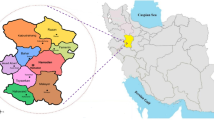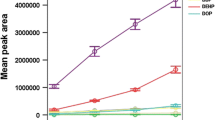Abstract
In the present study, magnetic solid phase extraction (MSPE) method and gas chromatography-mass spectrometry (GC/MS) technique were used to measure 6 PAE in fruit juice samples. The mean of total phthalic acid esters (ƩPAEs) in all samples was 3.55 ± 0.66 µg/L. The mean concentration of DEHP (bis(2-ethylhexyl) phthalate) in samples was 0.82 ± 0.31 µg/L, which was lower than the mentioned United States Environmental Protection Agency (USEPA) standard level in drinking water (6 μg/L for DEHP). The pineapple juice samples (4.44 ± 0.57 µg/L) and mango juice samples (2.77 ± 0. 1 µg/L) had maximum and minimum mean levels of ƩPAEs, respectively. Also, results showed that brand B (3.76 ± 0.87 µg/L) and samples in the time of expiration date (3.64 ± 0.72 µg/L) had the highest PAE levels. The rank order Chronic Daily Intake (95%) values for adults were DEHP (\(5.26E-04\)) > butylbenzyl phthalates (BBP) (\(4.73E-04\)) > diethyl phthalate (DEP) (\(3.77E-04\)) and for children were DEHP (\(9.93E-04\)) > BBP (9.07E-04) > DEP (\(7.01E-04\)), which were below the tolerable daily intake (TDI) value. The noncancer risk of PAEs based on the target hazard quotient (THQ) was acceptable (< 1). The results exhibited that the Incremental Lifetime Cancer Risk (ILCR) was below the permissible limit (< \(1E-04\)). Therefore, the risk of carcinogenicity and noncarcinogenicity of PAEs in juices does not have adverse effects on human health.



Similar content being viewed by others
Data availability
From the corresponding author, the datasets used and/or analyzed during the present research are existing (on reasonable request).
References
Ahmadloo M, Shariatifar N, Mahmoudi R, Qajarbeygi P, Moazzen M, Akbarzadeh A, Nazmara S, Dobaradaran S (2019) Assessment of polychlorinated biphenyls concentration in egg using GC-MS method. J Maz Univ Med Sci 28:69–81
Al-Saleh I, Elkhatib R (2014) Analysis of phthalates residues in apple juices produced in Saudi Arabia. J Food Meas Charact 8:373–380
Amiridou D, Voutsa D (2011) Alkylphenols and phthalates in bottled waters. J Hazard Mater 185:281–286
Arabameri M, Mohammadi Moghadam M, Monjazeb Marvdashti L, Mehdinia SM, Abdolshahi A, Dezianian A (2020) Pesticide residues in pistachio nut: a human risk assessment study. Int J Environ Anal Chem 102(16):3947–3960. https://doi.org/10.1080/03067319.2020.1777289
Cao X-L (2008) Determination of phthalates and adipate in bottled water by headspace solid-phase microextraction and gas chromatography/mass spectrometry. J Chromatogr A 1178:231–238
Cao Y, Liu J, Liu Y, Wang J, Hao X (2016) An integrated exposure assessment of phthalates for the general population in China based on both exposure scenario and biomonitoring estimation approaches. Regul Toxicol Pharmacol 74:34–41
da Silva CR, Sainara Maia Fernandes T, de Sousa AE, Tomé Oliveira J, Carvalho Guedes JA, Julião Zocolo G, Wagner de Sousa F, do Nascimento RF (2021) Potential risk of BPA and phthalates in commercial water bottles: a minireview. J Water Health 19:411–435
Dobaradaran S, Akhbarizadeh R, Mohammadi MJ, Izadi A, Keshtkar M, Tangestani M, Moazzen M, Shariatifar N, Mahmoodi M (2020) Determination of phthalates in bottled milk by a modified nano adsorbent: presence, effects of fat and storage time, and implications for human health. Microchem J 159:105516
EFSA Panel on Food Contact Materials E, Aids P, Silano V, Barat Baviera JM, Bolognesi C, Chesson A, Cocconcelli PS, Crebelli R, Gott DM, Grob K, Lampi E (2019) Update of the risk assessment of di-butylphthalate (DBP), butyl-benzyl-phthalate (BBP), bis (2-ethylhexyl) phthalate (DEHP), di-isononylphthalate (DINP) and di-isodecylphthalate (DIDP) for use in food contact materials. EFSA J 17:e05838
Eghbaljoo-Gharehgheshlaghi H, Shariatifar N, Arab A, Alizadeh-Sani M, sani IK, Asdagh A, Rostami M, Alikord M, Arabameri M (2020) The concentration and probabilistic health risk assessment of trace metals in three type of sesame seeds using ICP- OES in Iran. Int J Environ Anal Chem 102(17):5936–5950. https://doi.org/10.1080/03067319.2020.1804896
EPA (2009) Agency EUSEP. Integrated risk information system. Butyl benzyl phthalate (BBP), CASRN 85–68–7; di(2-ethylhexyl) phthalate (DEHP), CASRN 117–81–7; diethyl phthalate, CASRN 84–66–2; dibutyl phthalate (DBP), CASRN 84–74–2. Accessible at. https://cfpub.epa.gov/ncea/iris_drafts/simple_list.cfm. 2009
EPA (2011) Exposure Factors Handbook. 2011 ed., Final Report. Environmental Protection Agency, Washington, DC EPA/600/R-09/052F. https://www.epa.gov/
Farhoodi M, Emam-Djomeh Z, Ehsani MR, Oromiehie A (2008) Effect of environmental conditions on the migration of di (2-ethylhexyl) phthalate from PET bottles into yogurt drinks: influence of time, temperature, and food simulant. Arabian J Sci Eng 33:279–287
Kalantari N GM (2015) National Report of "The comprehensive study on household food consumption patterns and nutritional status of I.R.Iran. Nutrition Research Group, National Nutrition and Food Technology Research Institute, Shaheed Beheshti University of Medical Sciences, Ministry of Health
Karami H, Shariatifar N, Nazmara S, Moazzen M, Mahmoodi B, Khaneghah AM (2021) The concentration and probabilistic health risk of potentially toxic elements (PTEs) in edible mushrooms (wild and cultivated) samples collected from different cities of Iran. Biol Trace Elem Res 199:389–400
Karimi F, Shariatifar N, Rezaei M, Alikord M, Arabameri M (2021) Quantitative measurement of toxic metals and assessment of health risk in agricultural products food from Markazi Province of Iran. Int J Food Contam 8:1–7
Khalili F, Shariatifar N, Dehghani MH, Yaghmaeian K, Nodehi RN, Yaseri M, Arabameri M (2022) The analysis and probabilistic health risk assessment of polycyclic aromatic hydrocarbons in cereal products. Environ Sci Pollut Res 29(21):31099–31109. https://doi.org/10.1007/s11356-021-17337-1
Kiani A, Ahmadloo M, Shariatifar N, Moazzen M, Baghani AN, Khaniki GJ, Taghinezhad A, Kouhpayeh A, Khaneghah AM, Ghajarbeygi P (2018) Method development for determination of migrated phthalate acid esters from polyethylene terephthalate (PET) packaging into traditional Iranian drinking beverage (Doogh) samples: a novel approach of MSPE-GC/MS technique. Environ Sci Pollut Res 25:12728–12738
Kiani A, Ahmadloo M, Moazzen M, Shariatifar N, Shahsavari S, Arabameri M, Hasani MM, Azari A, Abdel-Wahhab MA (2021) Monitoring of polycyclic aromatic hydrocarbons and probabilistic health risk assessment in yogurt and butter in Iran. Food Sci Nutr 9:2114–2128
Kouhpayeh A, Moazzen M, Jahed Khaniki GR, Dobaradaran S, Shariatifar N, Ahmadloo M, Azari A, Nazmara S, Kiani A, Salari M (2017) Extraction and determination of phthalate esters (PAEs) in Doogh. J Maz Univ Med Sci 26:257–267
Li X, Zeng Z, Chen Y, Xu Y (2004) Determination of phthalate acid esters plasticizers in plastic by ultrasonic solvent extraction combined with solid-phase microextraction using calix [4] arene fiber. Talanta 63:1013–1019
Mehraie A, Shariatifar N, Arabameri M, Moazzen M, Mortazavian AM, Sheikh F, Sohrabvandi S (2022) Determination of phthalate acid esters (PAEs) in bottled water distributed in tehran: a health risk assessment study. Int J Environ Anal Chem 1–15. https://doi.org/10.1080/03067319.2022.2062239
Moazzen M, Ahmadkhaniha R, Gorji MEh, Yunesian M, Rastkari N (2013) Magnetic solid-phase extraction based on magnetic multi-walled carbon nanotubes for the determination of polycyclic aromatic hydrocarbons in grilled meat samples. Talanta 115:957–965
Moazzen M, Rastkari N, Alimohammadi M, Shariatifar N, Ahmadkhaniha R, Nazmara S (2014) Assessment of phthalate esters in a variety of carbonated beverages bottled in PET. J Environ Health Sci 2:7–18
Moazzen M, Mahvi AH, Shariatifar N, Jahed Khaniki G, Nazmara S, Alimohammadi M, Ahmadkhaniha R, Rastkari N, Ahmadloo M, Akbarzadeh A, Dobaradaran S, Norouzian Baghani A (2018) Determination of phthalate acid esters (PAEs) in carbonated soft drinks with MSPE/GC–MS method. Toxin Rev 37:319–326
Moazzen M, Khaneghah AM, Shariatifar N, Ahmadloo M, Eş I, Baghani AN, Yousefinejad S, Alimohammadi M, Azari A, Dobaradaran S (2019) Multi-walled carbon nanotubes modified with iron oxide and silver nanoparticles (MWCNT-Fe3O4/Ag) as a novel adsorbent for determining PAEs in carbonated soft drinks using magnetic SPE-GC/MS method. Arab J Chem 12:476–488
Moazzen M, Shariatifar N, Arabameri M, Hosseini H, Ahmadloo M (2022) Measurement of polycyclic aromatic hydrocarbons in baby food samples in Tehran Iran with magnetic-aolid-phase-extraction and gas-chromatography/mass-spectrometry method: a health risk assessment. Front Nutr 9833158. https://doi.org/10.3389/fnut.2022.833158
Rastkari N, Jeddi MZ, Yunesian M, Ahmadkhaniha R (2018) Effect of sunlight exposure on phthalates migration from plastic containers to packaged juices. J Environ Health Sci Eng 16:27–33
Rezaei M, Khorasgani ZN, Nakisa A, Imani N, Rezaee S, Khodayar MJ, Kalantari H (2015) Determination of polychlorinated dibenzo dioxin levels in fresh milk from the dairy factories of Southwest Iran. J Environ Anal Toxicol 5(2161–0525):1000
Rezaei H, Moazzen M, Shariatifar N, Khaniki GJ, Dehghani MH, Arabameri M, Alikord M (2021) Measurement of phthalate acid esters in non-alcoholic malt beverages by MSPE-GC/MS method in Tehran city: chemometrics. Environ Sci Pollut Res 28(37):51897–51907. https://doi.org/10.1007/s11356-021-14290-x
Roudbari A, Nazari RR, Shariatifar N, Moazzen M, Abdolshahi A, Mirzamohammadi S, Madani-Tonekaboni M, Delvarianzadeh M, Arabameri M (2021) Concentration and health risk assessment of polycyclic aromatic hydrocarbons in commercial tea and coffee samples marketed in Iran. Environ Sci Pollut Res 28:4827–4839
Samiee S, Fakhri Y, Sadighara P, Arabameri M, Rezaei M, Nabizadeh R, Shariatifar N, Khaneghah AM (2020) The concentration of polycyclic aromatic hydrocarbons (PAHs) in the processed meat samples collected from Iran’s market: a probabilistic health risk assessment study. Environ Sci Pollut Res 27(17):21126–21139. https://doi.org/10.1007/s11356-020-08413-z
Shahsavari S, Shariatifar N, Arabameri M, Mahmoudi R, Moazzen M, Ghajarbeygi P (2022) Analysis of polychlorinated biphenyls in cream and ice cream using modified QuEChERS extraction and GC-QqQ-MS/MS method: a risk assessment study. Int J Dairy Technol 75:448–459
Shariatifar N, Dadgar M, Fakhri Y, Shahsavari S, Moazzen M, Ahmadloo M, Kiani A, Aeenehvand S, Nazmara S, Khanegah AM (2020) Levels of polycyclic aromatic hydrocarbons in milk and milk powder samples and their likely risk assessment in Iranian population. J Food Compos Anal 85:103331
Shariatifar N, Moazzen M, Arabameri M, Moazzen M, Khaniki GJ, Sadighara P (2021b) Measurement of polycyclic aromatic hydrocarbons (PAHs) in edible mushrooms (raw, grilled and fried) using MSPE-GC/MS method: a risk assessment study. Appl Biol Chem 64:1–11
Shariatifar N, Seilani F, Jannat B, Nazmara S, Arabameri M (2022) The concentration and health risk assessment of trace elements in commercial soft drinks from Iran marketed. Int J Environ Anal Chem 102(16):4388–4402. https://doi.org/10.1080/03067319.2020.1784412
Sharman M, Read WA, Castle L, Gilbert J (1994) Levels of di-(2-ethylhexyl) phthalate and total phthalate esters in milk, cream, butter and cheese. Food Addit Contam 11:375–385
Tang Z, Kang T, Kang X (2019) Determination of five phthalate esters and bisphenol A in fruit juice by packed-nanofiber solid phase extraction coupled with gas chromatography. J Food Eng 8:50–54
Yaminifar S, Aeenehvand S, Ghelichkhani G, Ahmadloo M, Arabameri M, Moazzen M, Shariatifar N (2021) The measurement and health risk assessment of polychlorinated biphenyls in butter samples using the QuEChERS/GC-MS method. Int J Dairy Technol 74:737–746
Yin S, Yang Y, Yang D, Li Y, Jiang Y, Wu L, Sun C (2019) Determination of 11 phthalate esters in beverages by magnetic solid-phase extraction combined with high-performance liquid chromatography. J AOAC Int 102:1624–1631
Zare Jeddi M, Ahmadkhaniha R, Yunesian M, Rastkari N (2014) Magnetic solid-phase extraction based on modified magnetic nanoparticles for the determination of phthalate diesters in water samples. J Chromatogr Sci 53:385–391
Funding
This research has been supported by the Amol University of Special Modern Technologies and Tehran University of Medical Sciences.
Author information
Authors and Affiliations
Contributions
Fahimeh Tooryan and Nabi Shariatifar: conceptualization, supervision, design of study, and writing—reviewing and editing. Pegah Kargarghomsheh: writing—original draft, design of study, methodology, and writing—reviewing and editing. Mahsa Naghashan and Soraya Farhadiyan: visualization, investigation, methodology, software, and validation. Majid Arabameri: methodology, software, validation, data curation, and writing—original draft preparation.
Corresponding author
Ethics declarations
Ethics approval
This research does not contain any animal or human testing.
Consent to participate
Not applicable.
Consent for publication
Not applicable.
Competing interests
The authors declare no competing interest.
Additional information
Responsible Editor: Ester Heath
Publisher's note
Springer Nature remains neutral with regard to jurisdictional claims in published maps and institutional affiliations.
Supplementary Information
Below is the link to the electronic supplementary material.
Rights and permissions
Springer Nature or its licensor (e.g. a society or other partner) holds exclusive rights to this article under a publishing agreement with the author(s) or other rightsholder(s); author self-archiving of the accepted manuscript version of this article is solely governed by the terms of such publishing agreement and applicable law.
About this article
Cite this article
Kargarghomsheh, P., Naghashan, M., Farhadiyan, S. et al. Determination of phthalic acid esters (PAEs) along with probabilistic health risk assessment in fruit juice samples in Tehran, Iran. Environ Sci Pollut Res 30, 44833–44844 (2023). https://doi.org/10.1007/s11356-023-25313-0
Received:
Accepted:
Published:
Issue Date:
DOI: https://doi.org/10.1007/s11356-023-25313-0




